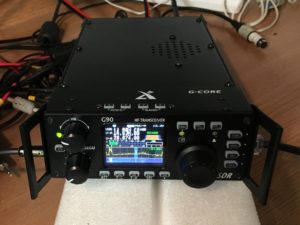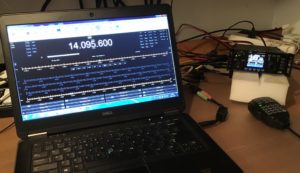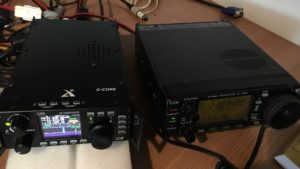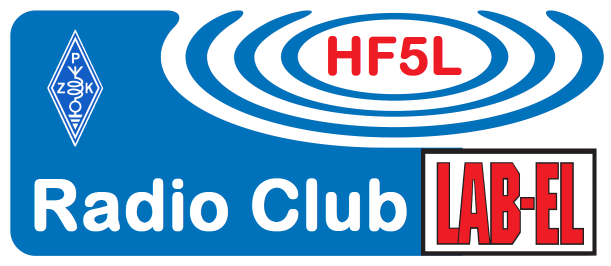QRP work has many advantages, especially during holiday trips. I have been practicing it for years – especially from the Greek islands. However, I have a problem: the elephant has stepped on my ear which I use to receive CW. Last time I was actively practicing CW on the RBM-1, as an operator of “Operation Bieszczady 40” in 1978. The power of several watts on the SSB is not overwhelming. My solution is to use digital emissions. I use the full power setting of radio, and techniques to decode transmissions at the noise level.
The current fashion in digital emissions is (unfortunately) FT8, one of the modes supported by the WSJT-X application. It allows you to “get the QSO” almost in automatic mode, but it does not allow to send anything “out of hand”. Timidly overcoming this is the JS8 Call, which is an attempt to create a network of stations which transmit information without the need of everybody hearing all other stations. Both protocols come from the works of K1JT. They require time synchronization of the radio stations. In practice, this is done by using time servers available on-line, thus requiring access to the Internet. An alternative solution are GPS time receivers, connected to the computers which control the radios. Shortwave radio operators dealing with asynchronous emissions (PSK-31 and faster, Olivia, RTTY) are still operating. In these modes you do not need to synchronize radio stations. These protocols are supported by applications such as Ham Radio Deluxe, FLDigi or WinWarbler.
 Holiday work usually imposes restrictions on the consumption of electrical power, the antenna system, and finally the dimensions and weight of the radio station. In SP reality, the most popular radio stations were ICOM IC-703 and YAESU FT-817 (or currently FT-818). Added to this are Elecraft products, and Chinese “implementations” of the mcHF radio. Recently (half a year ago) a new transceiver – Xiegu G90 became available. Descriptions of this radio are available from sellers, a fair opinion can be found in the eHam portal. The radio is designed and manufactured in China. It is an “almost SDR” transceiver (the first mixer is analog) for the KF band, with a nominal RF power of 20W. Has reasonable dimensions and parameters. The price is around 500 (USD in Chinese, and EURO in European stores). I recommend buying in the EU – no need to interact with the Customs Office, and you get the Swedish or French warranty, not Asian. I bought this radio for home and field work with digital emissions. For the interface with the laptop, a cable with galvanically isolated audio path is useful, and a USB<->CAT connection for radio control (USB<->CAT cable comes included with the radio equipment, it is used to change the firmware version). The ready – made audio/CAT interface is available from xggcomms.com.
Holiday work usually imposes restrictions on the consumption of electrical power, the antenna system, and finally the dimensions and weight of the radio station. In SP reality, the most popular radio stations were ICOM IC-703 and YAESU FT-817 (or currently FT-818). Added to this are Elecraft products, and Chinese “implementations” of the mcHF radio. Recently (half a year ago) a new transceiver – Xiegu G90 became available. Descriptions of this radio are available from sellers, a fair opinion can be found in the eHam portal. The radio is designed and manufactured in China. It is an “almost SDR” transceiver (the first mixer is analog) for the KF band, with a nominal RF power of 20W. Has reasonable dimensions and parameters. The price is around 500 (USD in Chinese, and EURO in European stores). I recommend buying in the EU – no need to interact with the Customs Office, and you get the Swedish or French warranty, not Asian. I bought this radio for home and field work with digital emissions. For the interface with the laptop, a cable with galvanically isolated audio path is useful, and a USB<->CAT connection for radio control (USB<->CAT cable comes included with the radio equipment, it is used to change the firmware version). The ready – made audio/CAT interface is available from xggcomms.com.
After a few months of use, I can say that the radio is OK. I had one problem requiring soldering: the power fuse socket melted (in the 12VDC cable), I had to replace it for a more durable one. The advantages of the radio include:
– built-in input filters, single-stage pre – amplifier and RF attenuator, antenna tuner;
– solid mechanical construction;
– detachable front panel;
– max. power supply 8A @ 12VDC => can be powered from the car socket;
– no fan (OK for SSB, but limits the setting of the maximum power in digital emissions to approx. 5W, to avoid overheating during a 2-minute continuous transmission);
– reasonable quality and organization of the screen (on the surface of 3 x 3 cm, even a tiny waterfall was stowed);
– the possibility of firmware versions upgrade (currently 1.6) .
The disadvantage of the radio is the power consumption in the reception mode, much higher than in the case of IC-703 (about 600 mA vs. 300 mA). Unfortunately, two processors and the screen work all the time and draw power. For SSB amateurs, the disadvantages will be: the lack of RIT and of controlled TX audio compression.
Typically for products from China, user documentation is very rudimentary, no technical documentation is available. For digital operation, the radio should be declared as ICOM 7000 (it even has the same microphone). Unfortunately, ICOM emulation is not perfect, and trouble-free work requires special arrangements. As a layer of “Rig Control” I use Ham Radio Deluxe (to which I declare that radio is ICOM 7000). For the higher-level applications (WSJT-X etc.), I declare that radio is HRD. Swedish radio salesman uses the OmniRig program instead of HRD, but the one on my computer crashes. HRD is also always on for another reason: it allows me to control the radio from the computer screen, without the need to use the glasses when operating the radio directly from the front panel.


For now, XIEGU G90 and ICOM 703 stand side by side. If I had confidence that XIEGU in 10 years would work as well as the old ICOM works now, I would send ICOM to retire. Until then – I will wait.
Marek SP5ISZ

Number of Comments: 4
It is now time for a holiday test, how TRX will behave in a coastal, saline and sandy atmosphere. By the way, it is puzzling why a small side is chosen as a front plate in such small devices. On the longer one can fit more elements, bigger display.
Zbyszek SP5JSZ
The front panel is detachable, maybe to be easy to mount in the car.
Mirek SP5GNI
I did not find any G90 block diagram in the network, but from the description in the manual it would appear that after the intermediate frequency conversion it has a very wide bandwidth – of the order of 50 kHz. The second conversion gives the signal in the range of 0-48 kHz, which is sampled by a 24-bit analog-to-digital converter. This is of course a typical converter from the audio segment, probably a codec that has two-way processing (the digital-to-analog converter would be used for transmitting). The whole selectivity of the receiver comes from digital filtration, i.e. processing of the sampled signals in the signal processor. Only with this configuration it is possible to view the spectrum/waterfall in the 48 kHz band in real time. Consequently, the receiver will be very sensitive to strong stations operating at a distance of +/- 24 kHz from the operating frequency. Intermodulation products that appear at the analog-to-digital converter input can not be filtered out be any digital filter!
More pictures can be found here.
Mirek SP5GNI
Bob AB5N has published an excellent video about Xiegu G90:
https://www.youtube.com/watch?v=I6dK2_QIn-s&feature=youtu.be
He discusses in detail the design and operation of this transceiver, and additionally gives a REALLY very interesting lecture on the SDR technique, its variants, features and advantages compared to traditional analog technique.
I would recommend!
Mirek SP5GNI